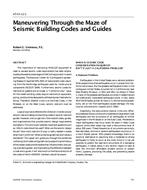Thermal environment perception differences between males and females were tested for various airflow, ambient temperature, and metabolic rate conditions. Thermal environments are transient because of the way various thermal factors interact. A factorial test was conducted to quantify the interaction effects of three major comfort factors in relation to gender differences. Test results showed that females consistently felt warmer and more uncomfortable than males under the same conditions. Test results showed that metabolic rate has more a pronounced effect on thermal comfort than does room temperature for transient and high metabolic rate conditions. Test results also showed that neutral temperatures in which people felt neither cool nor warm were 26.4°C (79.5°F) for males and 23.9°C (75°F) for females. Consecutive exercise sessions during the tests showed that male thermal sensation has a linear increase in time, whereas female thermal sensation increases earlier than males resulting, in less tolerance towards the warm conditions.
Product Details
- Published:
- 2013
- Number of Pages:
- 11
- File Size:
- 1 file , 2.8 MB
- Product Code(s):
- D-DE-13-005
- Note:
- This product is unavailable in Russia, Belarus


